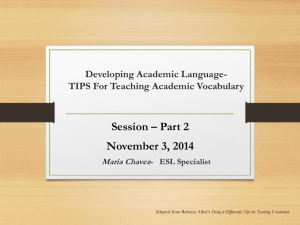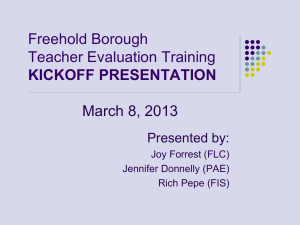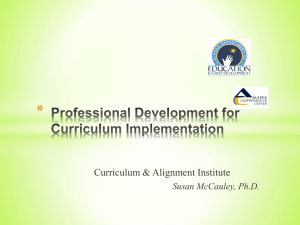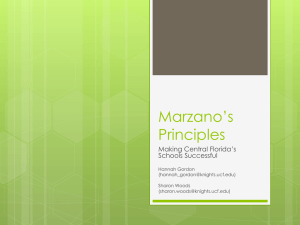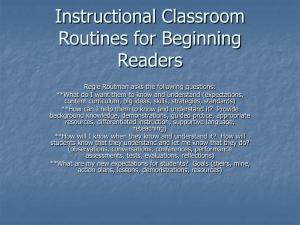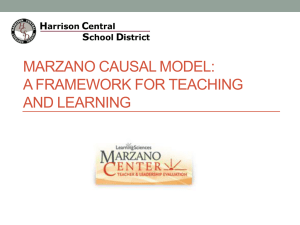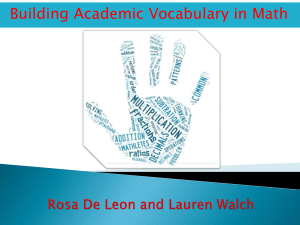2011-12 SCPS Instructional Evaluation System
advertisement
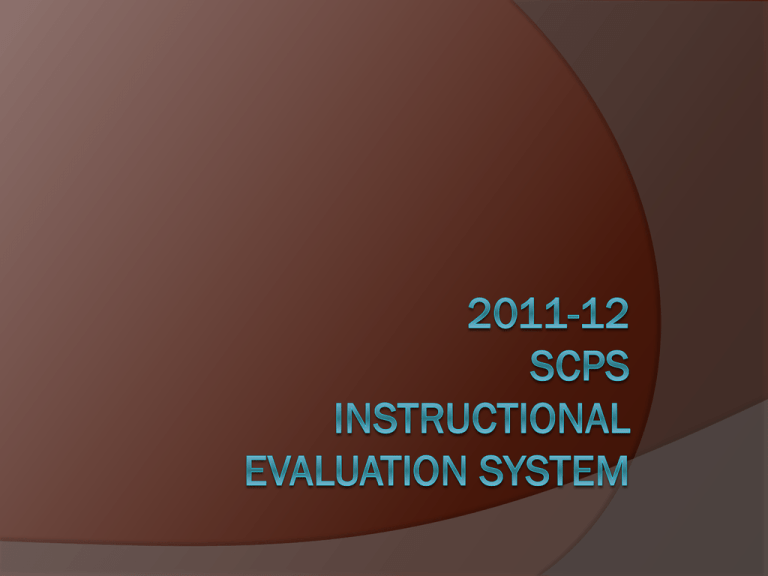
SCPS is… We are a high-performing district We are focused on student achievement We are committed to achieving excellence and equity through continuous improvement We are ready to take the next step for our students! The Old Evaluation System: Observations primarily for evaluation Limited feedback on teaching strategies No link between evaluation and student performance/achievement/growth No link between evaluation and PD Why? Our students are changing Our understanding of learning has changed Our workplaces are changing This change presents an OPPORTUNITY to help our students grow Policymaking Race to the Top priorities Great Teachers & Leaders Human capital decisions Senate Bill 736 (“Student Success Act”) All employees get an annual evaluation with a final rating Supervisor appraisal + student learning growth Underlying Philosophy: Teachers are the single most important variable in a student’s academic growth. Teachers who effectively implement research-based practices will see student learning growth. Our Goal Rigorous, transparent and fair evaluation systems that differentiate teacher effectiveness with data on student growth and include timely and constructive feedback The SCPS Commitment to Teachers We will implement a process that is: Accurate, Transparent, Fair, Reliable Constructive, Meaningful Aligned with instruction, curriculum, and assessment Linked to professional growth State Requirements Teachers & school-based administrators Evaluations based on a core of effective practices Research-based Aligned with Florida Educator Accomplished Practices (revised 12/10) Evaluation for all instructional personnel every year that leads to a final rating Marzano Causal Teaching Model Applied researcher Art & Science of Teaching Strategies Effect sizes Causal teaching model 10 design questions 60 strategies Theory of student achievement Marzano’s Four Domains 1) Classroom Strategies/Behaviors 2) Planning and Preparing 3) Reflecting on Performance 4) Collegiality and Professionalism RESOURCES Marzano Placemat KEY QUESTION: How does Domain 1 link to Domains 2-4? Types of Assessments Formative Summative Shape, form or improve teacher practice Quality Assurance • Observations can be formative or summative • Observations are an opportunity to gather evidence of effectiveness Sources of Evidence Domain 1: Classroom Strategies & Behaviors • Formal observation(s) • Informal, announced observation • Informal, unannounced observation • Walkthroughs • Videos of classroom practice • Artifacts Domain 3: Reflecting on Teaching • Self-assessment • Reflection conference • Professional Growth Plan • Conferences • Discussions • Artifacts Domain 2: Planning and Preparing • Planning conference or preconference • Artifacts Domain 4: Collegiality & Professionalism • Conferences • Discussions • Artifacts How will I be evaluated? New to district = 2 evaluations per year Everyone else = 1 evaluation per year Evaluation = Supervisor appraisal Student learning growth data Annual Teacher Evaluation Student Learning Growth, 50% Instructional Practice, 50% Instructional Practice—50% Evaluation by administrator on approved instrument Rating for each applicable indicator: 4 Ratings Used For Each Domain Element 3 2 1 Needs Highly Unsatisfactory Effective Improvement/ Effective Developing Important Clarifications: There is no requirement that a teacher use or be evaluated on all 60 elements. Elements can be rated not applicable with NO PENALTY to the teacher. Effective implementation of some elements is preferred over mediocre or inappropriate implementation of all elements. Student Learning (50%) Based on student learning growth FDOE must develop learning growth formulas --Student Growth Implementation Committee --Value-added model --FCAT formula for 2011-12; others to be added later More information coming soon! Final Annual Rating Highly effective Effective Needs Improvement/Developing* Category I: first 3 years—developing Category II: 4+ years—needs improvement Unsatisfactory How will results be used? Generate conversation about the district’s strategic plans and goals Lead to action plan items in School Improvement Plans Inform decisions about curriculum, instruction, assessment, and PD for 2012-13 Align with teachers’ IPDPs in 2012-13 What about merit pay? Merit pay is another application of evaluation. The evaluation system can improve student learning with or without merit pay. Under SB 736, merit pay does not begin until 2014-15. Our short-term focus is implementing an effective evaluation system. Merit pay is a long-term issue. So what happens next? Pending School Board approval… Administrator training Marzano Domain 1 (3 days) Marzano Domains 2-4 (1 day) Online tool & PD system (3 days) Practice walkthroughs and observations Accuracy Inter-rater reliability Teacher-administrator conversations IPDPs Walkthrough/observation follow-ups SCPS & SEA SCPS and SEA have partnered throughout this process. SEA has participated in all committee meetings and DOE work sessions. Evaluation processes are subject to collective bargaining. Supports for Teachers Teacher Evaluation Committee Trained teacher-leaders Professional District staff development Recipe for Success Everyone: Learning a new common language of instruction Teachers: Studying and implementing research-based strategies Administrators: Collaborating to build accuracy and achieve inter-rater reliability OUR COMPACT This process will be a transition for both teachers and administrators. We want to have a successful transition. Therefore, we will have frequent, open conversations about the language of instruction and the Marzano strategies. Questions 31

